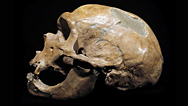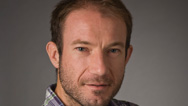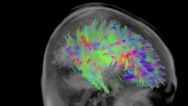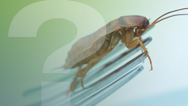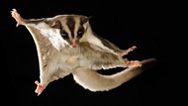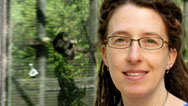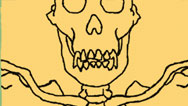
What Makes Us Human?
Find out if you're part Neanderthal, about the evolution of laughter, what language may owe to tool-making, and more. Airing October 10, 2012 at 9 pm on PBS Aired October 10, 2012 on PBS
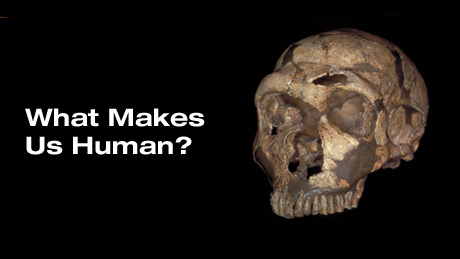
Program Description
Transcript
What Makes Us Human.
PBS Airdate: October 10, 2012
DAVID POGUE: What sets humans apart from all the other animals?
I'm David Pogue, and on this episode of NOVA scienceNOW, I'm stepping back in time to uncover secrets of human evolution and what made us the way we are.
We're tackling some of the biggest mysteries in the history of our species, like the origin of language…
You can tell by looking at the bones if people could talk or not?
…and smashing age old myths.
I have created a tool!
Is it possible that our ability to talk lies in this ancient rock?
THIERRY CHAMINADE (Aix-Marseille University): These areas of the brain are necessary both for language and stone-tool-making.
DAVID POGUE: And language isn't the only thing that's different about humans. What about laughter? Are we the only animals that laugh?
Oh, my gosh. It doesn't sound all that laughy. It sounds a little bit more like, "I'm going to kill you now."
And is it possible that our ancient relatives, the Neanderthals live on in some of us?
ED GREEN (University of California, Santa Cruz): We have run this scan across your entire genome.
DAVID POGUE: No, no. It's not true!
In this episode, I'm finding out What Makes Us Human? Up next, on NOVA scienceNOW.
Can you imagine if more than one species of human were walking around today? I'm not talking about people who just look different, I'm talking about people who are different, like Neanderthal-different.
One of the best ways to understand what makes us truly human is to study those ancient Neanderthal cousins. And they're telling us amazing new things about a time on Earth when we weren't all alone.
It may seem shocking, but this is common in lots of animals. Just look at fish; there are 500 kinds of rays. And sharks alone have over 400 different species; 4,000 species of frogs; seven kinds of penguins.
The idea of another species of human sharing our cities isn't that farfetched. Around 30,000 years ago, there were at least four different kinds of hominids coexisting on the planet, including the Neanderthals. More than a million years ago, some of our ancestors began making their way from Africa to Europe, while the rest stayed behind. Those who remained in Africa evolved into us, modern humans. The group that went to Europe eventually developed into Neanderthals.
You know the Neanderthals, otherwise known as "cavemen." Most people think of them as being a bunch of brutes. Well, it turns out, that the more we learn about them, the closer they seem to us.
Their bones were first identified in Germany, in the Neander Valley, thus, Neanderthals. Since that discovery, about a hundred and fifty years ago, scores of Neanderthal sites have been uncovered, from the British Isles to Western Asia. We now know that Neanderthals used fire, wore clothing and made stone tools.
They thrived as skilled hunter/gatherers for at least 200,000 years. But then, thirty thousand years ago, they vanished. Why didn't they survive? And why aren't they living among us today?
Daniel Lieberman, of Harvard, looks for answers in the way human heads have evolved.
Why the head?.
DANIEL LIEBERMAN (Harvard University): Well, heads are one of the most important things about our bodies, and they're actually what makes us special, for the most part. If you were to meet a Neanderthal on, say, the subway, from the neck down you'd be basically the same. And what really makes you different from a Neanderthal is above the neck.
DAVID POGUE: It turns out our skulls and Neanderthal skulls are pretty different.
All right, so this is a mockup of a modern human?
DANIEL LIEBERMAN: Right.
DAVID POGUE: "Hi, Dan".
And this is our Neanderthal guy. If we wanted to establish the differences between the two, specifically what would you point out?
DANIEL LIEBERMAN: There are really two basic essential differences that matter. And the first is that a modern human head is much more globular. It's much more spherical, more like a soccer ball, right? It's rounded. Right? But the Neanderthal head, if you can see here, is much longer and lower. It's more like a lemon or an American football, right?
DAVID POGUE: If our skulls are the main difference between modern humans and Neanderthals, perhaps that's the key to why Neanderthals died out and we survived.
To better understand how great the difference is between our heads and theirs, I've decided to have my own noggin expanded and Neanderthalized.
Yeah, exactly…
PAUL THEREN: And in terms of your arms, you feel comfortable?
DAVID POGUE: Yeah.
Paul Theren teaches advanced film makeup at the Academy of Arts, in San Francisco.
PAUL THEREN: So make sure you get a good little glob of it there, too.
DAVID POGUE: He has agreed to take me back 40,000 years and fix me up on a date with a Neanderthal.
It's a big night, you know? It's the prom, so make me look good.
Now, suppose we wanted to make a movie about a Neanderthal guy. How would we begin to make up this guy to make him look more like a Neanderthal?
DANIEL LIEBERMAN: You want to make the face bigger, so you would add stuff to the front of the face and pull the face out as much as you could.
DAVID POGUE: My new face isn't a mask, it goes on in pieces: an enormous nose, swept-back cheekbones…
PAUL THEREN: Hold that down, hold that down. That's good.
DAVID POGUE: …really heavy brow ridges.
DANIEL LIEBERMAN: Its face is enormous. It's 20 to 30 or 40 percent larger than any modern human.
DAVID POGUE: Enlarging the back of my head takes a pound of silicone and a pint of glue.
DANIEL LIEBERMAN: You could at least approximate the shape of a Neanderthal head by adding plastic or whatever they do and give it this characteristic long shape. It's almost as if somebody took their, their fist inside the brain and just sort of punched, punched it out backwards.
DAVID POGUE: And flowing from that enormous head? Red hair. Some Neanderthals were fair skinned redheads, according to D.N.A. evidence. This would have helped their bodies generate vitamin D in the weak northern sun.
DANIEL LIEBERMAN: It's funny though, if you think about all the reconstructions you see about Neanderthals, they always give them bad hair. For some reason everybody assumes that they had no hairstyle, and I wonder about that.
DAVID POGUE: After four hours in the chair, my time travel is complete.
PAUL THEREN: I think we're, we're there.
MAKEUP ARTIST: …you still look like you're wearing…
DAVID POGUE: I am alive!
MAKEUP ARTIST: Oh, my god.
DAVID POGUE: Oh, my god.
All right, I'm ready for the streets.
If I saw this guy walking down the street, carrying a briefcase and a cell phone, would I know at a glance there was something substantially different, or would he pass for one of us?
DANIEL LIEBERMAN: I think you would probably figure out this was an extremely ugly and strange human being, but you probably wouldn't want to, like, rush and put him in a zoo. I mean you would just simply think, "Gosh, he's got a long low head and big brow ridges and a ridiculously large face and maybe a strange nose. Perhaps he needs to see a dentist." But you probably wouldn't otherwise react too strongly, I suspect.
MOUNTED POLICE OFFICER: How you guys doing?
DAVID POGUE: No doubt Neanderthals would have thought small-faced humans were the strange and ugly ones, but does the difference in our head size and shape explain why we survived and Neanderthals died out?
DANIEL LIEBERMAN: So one of the questions is, "What is it about the modern human head that might have given us some kind of advantage?" And one possibility is our brain. Our brains aren't any bigger than Neanderthals'. They might have had a different structure.
DAVID POGUE: Scientists can reconstruct the size and shape of the Neanderthal brain, by creating a cast of the inside of the skull. Where the brain pushes up against the bone, it leaves an impression of what had been there thousands of years ago.
In two areas—the temporal lobe, a center for hearing, language, and speech; and the parietal lobe, active in understanding spatial relationships—our ancestors' brains seem to be more developed than Neanderthals'.
DANIEL LIEBERMAN: So there might have been some differences in the shape of the brain that give us some clues that modern humans had cognitive abilities that were different.
DAVID POGUE: So their brains might have been bigger, but our brains might have been better.
DANIEL LIEBERMAN: That's a hypothesis. I wouldn't bet my mortgage on that yet.
The difference in our brains may have been key to our survival or it may have had nothing to do with why the Neanderthals died out. After all, lots of intellectually-challenged creatures survive without a problem.
DAVID POGUE: No can do.
But when scientists consider Neanderthals and humans, they see some possible advantages for our side: smaller heads and slimmer frames might have allowed us to outrun and outhunt our lumbering cousins; our brains and vocal cords may have been better equipped for language, meaning we could work together and plan more effectively than they could; and we may have had more babies and simply crowded them out.
All of this is speculation, but recently, scientists found a whole new window into the lives of our long-lost cousins. They successfully mapped the Neanderthal genome. And it's revealing some surprising answers, not only about them, but about us, too.
Geneticists at the Max Planck Institute, in Germany, worked for years to extract D.N.A. from the ancient bones and unlock the secrets of their genetic code.
Ed Green is one of those geneticists, and he's been analyzing the stream of letters that represent the twists and turns of the Neanderthal genome.
ED GREEN: So D.N.A. is composed of these four nucleotides. We abbreviate them A, C, G and T. Chemically, they're slightly different.
And it's the order of this A, C, G and T that encodes information, just like the order of letters in our alphabet encodes information in words.
DAVID POGUE: In human D.N.A., how these four molecules line up, over three billion times, determines who we are.
ED GREEN: It's all there. All the information is there. These four letters encode all of life.
DAVID POGUE: So what secrets are encoded in the ancient Neanderthal D.N.A.? How does it compare to our own?
Ed Green and his team lined up the Neanderthal genome with that of modern humans. Most of our sequences matched perfectly—that was expected since we share an ancient ancestor—but, time and again, something odd appeared: some people were carrying mutations characteristic of Neanderthals.
Those changes to the D.N.A. would have occurred after the Neanderthals evolved in their isolated pocket of the world. According to Ed Green, this points to one thing.
ED GREEN: They had sex; they had descendants. We find this trace in our genome today. Amazing.
DAVID POGUE: Neanderthal's genes alive in us?
Okay, the suspense is killing me. I've got to check this out to see if I, too, carry the Neanderthal gene within me.
There are several private services now offering to decode your personal genome, including whether you have any Neanderthal D.N.A. You simply spit in the tube, wrap it up and send it off. The company sends you the results in a matter of weeks.
Me? I'm going a step further.
Hey, are you Ed?
I'm getting my results from none other than Ed Green, the geneticist from the team that first mapped the Neanderthal genome. And I'm going to get to the bottom of this sensational story.
ED GREEN: I won't say get your mind out of the gutter. It's just as, it's just as dirty as you say it. There was sex between humans and Neanderthals at some point in the past, and their genes wound up, through this interbreeding event, in the genomes of some people who are alive today.
DAVID POGUE: Okay, so what did you find out about me?
ED GREEN: We have run this scan across your entire genome, but I'll show you, kind of, what we have done for one chromosome. This is chromosome 12.
DAVID POGUE: Ed Green checked the data on one of my chromosomes to see if there was any evidence of Neanderthal genes in me.
It all comes down to how those four base letters line up, on the human side or the Neanderthal side.
Ed points out to me one tiny but significant sequence.
ED GREEN: We can look at what bases occur in humans that are not of Neanderthal ancestry. You see it's the CTCT-C-G. And we know, from sequencing the Neanderthal, that they look like CTCT-T-G. And now, we can ask, do you look like the Neanderthal, or do you look like most of the humans up here? And it turns out, for this region, you have CTCT-T-G. And it's the Neanderthal.
DAVID POGUE: No, no. It's not true!
ED GREEN: Take as much time as you need.
DAVID POGUE: This changes my whole view of myself as a sophisticated, modern, sensitive man.
ED GREEN: Well, um, not only do you have a Neanderthal gene, you have many Neanderthal genes. In sum total, you are, according to the 23andMe analysis, 2.6 percent Neanderthal ancestry.
DAVID POGUE: Oh!
Do you have the Neanderthal gene?
ED GREEN: Um, I have several Neanderthal genes. I've come to grips with this though, I think.
DAVID POGUE: In fact, all humans alive on Earth, today, have them, except for most Africans, because their ancestors never met up with the Neanderthals. If you are a descendent of the modern humans who left Africa over 50,000 years ago, you have between one and four percent Neanderthal genes within you.
So we may not see Neanderthals among us, but they are still here, within us.
So, you're saying that Neanderthals today are extinct?
ED GREEN: They are extinct.
DAVID POGUE: But, but don't they, in a way, live on, because we have their D.N.A.?
ED GREEN: This is true. In that way, Neanderthals are not extinct.
DAVID POGUE: We are still coming to grips with the fact that Neanderthal genes live on in us.
While it's too early to tell what it all means, there are some indications that Neanderthal genes are present in our immune system, the part of the body that fights disease.
Some scientists believe that adding Neanderthal genes to our own may have helped us survive strange diseases, as we fanned out across the earth. Perhaps that may have had something to do with our surviving our Neanderthal cousins and going on to create civilization as we know it.
Did Neanderthals care
About their looks?
Inside Neanderthal caves,
Archeologists have found
Seashells and mineral pigment
That some say were used for…
Jewelry and make-up!
Well, maybe she's no Kim Kardashian…
But for 50,000 BC,
She's making an effort.
DAVID POGUE: There's one thing that shows up on all of the lists of what makes us human: language. Our ability to share our thoughts and complex information with others far surpasses all the barks, squeaks and growls of our animal friends.
So where did it come from? Believe it or not, the origin of language is one of the biggest mysteries in human evolution, but could an amazing new solution be found in this suitcase?
Inside, anthropologist David Frayer, of the University of Kansas, has samples of the kind of evidence scientists depend on to trace the history of language.
Oh, man, this is the briefcase you carry around?
You could tell by looking at the bones if people could talk or not?
DAVID FRAYER (University of Kansas): Well, with various levels of success, yes.
DAVID POGUE: Frayer brought me all kinds of stuff, from a Neanderthal skull and brain casts to a tiny bone found in our throat that helps us speak. But our language investigation soon centers on the oldest skull in Frayer's case.
DAVID FRAYER: We can take a leap back to this specimen, back to around 1.8 million years ago. When it was found, it was considered to be really revolutionary, because it showed this really large brain.
DAVID POGUE: The brain of this Homo erectus is much smaller than our modern brains, but twice the size of a chimpanzee brain. So this ancient ancestor might have had the capacity for language.
DAVID FRAYER: It suggests that language was possible in the individual.
DAVID POGUE: So, that's a little mind blowing—or skull blowing, I should say—that 1.8 million years ago, we might have had speech.
DAVID FRAYER: Now, whether they were stringing together the grammar and the syntax that we associate with modern language or modern writing, that's anyone's guess.
DAVID POGUE: The remains of early humans are extremely rare, and, of course all the soft tissue —noses, ears, tongues—that may be clues to speech are long gone, but Frayer does have one more item that may be a key clue to the origins of language.
It's not a skull, it's not even a bone. It's a rock?
DAVID FRAYER: It's more than a rock, it's a symmetrical tool.
DAVID POGUE: But I thought we were talking about language.
DAVID FRAYER: You go with what you got, sometimes, you know? When you're at 2,000,000 years ago, you don't have a lot of complete fossils. But what this tells us is that mindset of…the individual that made this had a brain that was thinking about a shape, when they were making the tool, as opposed to just whacking away at a rock.
DAVID POGUE: It turns out, when scientists are looking at the mysterious business of where language began, stone tools provide some of their best clues, because they offer a tiny glimpse into the workings of an ancient mind.
Something called the "Oldowan chopper," which looks like a charcoal briquet, is considered the first tool, two and a half million years old. But scientists get really jazzed when it comes to another tool, the "Acheulean handaxe," the very tool David Frayer is waving in front of my face.
DAVID FRAYER: This kind of tool involves a different kind of thought process. Chimpanzees make tools like this. If I held these two tools up and I said, "Which kind of tool would you think was made by a human-like ancestor as opposed to something else?" I think you would say the symmetrical one.
DAVID POGUE: For sure.
The Acheulean handaxe was born when Homo erectus got a bright idea for stone tool 2.0: a new product that was flat, sharp on the edges and could be used to perform a variety of essential tasks.
One and a half million years ago, it was the smartphone of its day.
Dietrich Stout at Emory University is investigating the possibility that making the Acheulean handaxe actually helped prepare the brain for language.
DIETRICH "DIETZ" STOUT (Emory University): The hypothesis is that learning to make more complicated stone tools caused evolutionary changes in the brain that paved the way for the evolution of language.
DAVID POGUE: Now that's an intriguing hypothesis: a million years of, years of making a gazillion stone tools may have established pathways in the brain humans could use for something else: language.
But how could you prove such an idea?
Stout turned to Bruce Bradley, experimental archeologist and stone-toolmaker extraordinaire, to try to understand the mental skills required to craft these ancient objects.
Bradley has trained himself to make stone tools using the same materials early humans would have used.
And now, he's agreed to give me a short lesson in tool-making…
BRUCE BRADLEY (University of Exeter): It's more finesse than it is strength.
DAVID POGUE: …so that I can step back in time and enter the mind of my ancient ancestors.
If a common Homo erectus can do it, I'm sure I can too.
BRUCE BRADLEY: Now, this is the piece that you're going to hit.
DAVID POGUE: Okay.
BRUCE BRADLEY: And this is the hammer stone that you're going to use. Just give that a try.
DAVID POGUE: All right.
BRUCE BRADLEY: It's finesse, not power.
Sort of a glancing blow: rather than into it, you want to glance it.
DAVID POGUE: All right.
BRUCE BRADLEY: Not too hard. You don't need to hit it that hard.
DAVID POGUE: Not so hard? Okay.
BRUCE BRADLEY: Uh, you're turning…you need your elbow up. That'll help your wrist, and not, not inward, outward.
DAVID POGUE: Okay.
BRUCE BRADLEY: There you go. Look at that.
DAVID POGUE: Wow.
I have created a tool! Civilization has changed forever, Og!
BRUCE BRADLEY: Yes, I'm sure.
Try again.
DAVID POGUE: My moment of triumph is brief. Getting from flake to handaxe proves far more complicated than I imagined.
BRUCE BRADLEY: And remember, glancing blow, elbow up.
DAVID POGUE: Maybe you should just do it.
BRUCE BRADLEY: No, no, no.
DAVID POGUE: Okay.
When rock star Bruce Bradley's making a tool, he's thinking several steps ahead, using more brain than brawn, a key point for Dietrich Stout.
DIETZ STOUT: There's a structure to the actions. There are certain rules. In order to do this, you have to do that, but all the time they are related to the goal. And it's the same thing in language.
DAVID POGUE: Just as words in their proper places form sentences, each individual strike must be done in the proper order to get the desired result: a flat stone blade.
BRUCE BRADLEY: So what we're looking at is complex, sequential, abstract thought. Because what is language? It's complex sequential thought, okay?
DAVID POGUE: I see. So in order to have language, you first have to have the same sorts of mental skills that, that we're seeing.
BRUCE BRADLEY: That's what we're trying to figure out.
DAVID POGUE: But for the tool-to-language hypothesis to work, there would have to be similarities between what the brain is doing while making a handaxe, and how it behaves while forming a sentence.
That's something Dr. Cynthia Thompson, at Northwestern University, knows a lot about.
CYNTHIA THOMPSON (Northwestern University): The focus of my research is to look at what parts of our brain are actually activated when we compute very difficult sentences.
DAVID POGUE: Thompson works with people who have trouble speaking because their brains have been damaged by stroke or other injuries.
Kristen Carlstedt, is one of her research subjects.
Following a stroke, four years ago, Kristen became one of a million Americans with a condition called "aphasia".
CYNTHIA THOMPSON: Kristen has classic agrammatic aphasia.
So, she can understand single words, she can produce single words.
ELLYN (Therapist): Okay, what's this?
KRISTEN CARLSTEDT (Research Subject): Um, pitcher…
CINDY THOMPSON: But people with agrammatic aphasia have problems with complex sentence processing.
ELLYN: The cat is chased by the dog.
What would you say for this one?
KRISTEN CARLSTEDT: The dog, no, the cat is…hmm.
DAVID POGUE: Thompson searches for answers in the images of brains of Kristen and other patients like her.
In M.R.I. brain scans, dark areas mean damaged tissue. Thompson found that agrammatic aphasia patients do share a striking characteristic, damage to the left hemisphere of the brain, home to a mysterious region known as Broca's area.
One of the many parts of the brain associated with language, Broca's area's seems especially important when it comes to grammar.
CINDY THOMPSON: Broca's area is, is crucial to sentence processing. When we have patients who have stroke, and they have damage that encroaches on Broca's area, that's when we start to see problems with sentences.
DAVID POGUE: Okay, fine, but does Broca's area have anything to do with stone-tool-making.
DIETZ STOUT: What we want to know is do, in fact, particular kinds of stone-tool-making, that we see coming along at particular times in human evolution, draw on or recruit Broca's area.
DAVID POGUE: Stout, himself, recruited a French neurologist, Thierry Chaminade, to set up an experiment that could answer that question.
Since it's impossible to have people actually make stone tools while having their brains scanned, Chaminade set up the next best thing: a special projector that could beam images of stone-tool-making into the M.R.I. machine.
Studies have shown that watching an activity excites the same areas of the brain as actually performing the activity.
THIERRY CHAMINADE: The same brain area responds when you observe someone else doing the action. So perceiving and performing an action activates the same regions.
DAVID POGUE: So, in order to see what areas of the brain are activated by making stone tools, Chaminade projected images onto a screen, in the M.R.I., and had subjects watch videos of Bruce Bradley at work.
In one video, the subjects were observing the creation of a simple tool, the Oldowan chopper. In another, they were observing a complex tool, the Acheulean handaxe.
The results were, pardon the pun, striking. Watching the video of simple choppers resulted in mild activity in Broca's area, but observing the complex Acheulean handaxe caused four times more activity.
So, the same area of the brain we use in forming complex sentences is also hard at work when we make complex tools.
THIERRY CHAMINADE: These areas of the brain are necessary both for language and stone-tool-making. These two things co-evolved.
DAVID FRAYER: It's probably the most interesting breakthrough about the origin of language, which pushes it way back to just a little less than 2,000,000 years ago, totally fascinating studies.
DAVID POGUE: Today, there are over 7,000 languages spoken throughout the world. They may sound different, but in every case, they're drawing on the same regions of the brain.
If you had told me that stone-tool-making had something to do with our ability to speak, I would have said you've got rocks in your head, but these studies indicate that once Homo erectus got creative with stone, our brains were on the way to inventing the most powerful tool of all: language.
Look at that. Look at that. Let the crowds roar! That is a masterpiece, don't you think?
BRUCE BRADLEY: It's delightful.
How early in life do babies
Start to learn language?
Could it be…in the womb?
Studies of newborn babies
Found that their cries mimic
The speech patterns of their mothers.
French newborns cry
More with a rising pitch
German cries have
A falling pitch
So when you hear this…
Remember, there could be
A lot more going on
Than a wet diaper.
DAVID POGUE: We may enter the world crying, but after about three months, we humans start doing something really weird. We begin to laugh.
Home videos on the Web featuring baby laughter get tens of millions of hits. Why would so many people feel compelled to watch babies simply laughing?
Dr. Gina Mireault studies baby laughter. She says home movies, posted on the Web, support her research in the lab, revealing that laughter is less about humor and more about the serious business of survival.
GINA MIREAULT (Johnson State College): Smiling and laughter are hardwired into the system. Newborn babies smile, they smile in their sleep. It's an involuntary reflex, so this is something that they come equipped to do, ready to do.
DAVID POGUE: Let's face it, human babies are weak creatures, more vulnerable than any other animal babies. We can't walk, we can't talk, we can't get our own food.
But we can laugh and, according to Mireault, that's a powerful secret weapon to get adults fully our side.
GINA MIREAULT: And what we found, with these very young babies, is that, when you tell parents, "Do whatever you normally do to get the baby to laugh," parents do some really outlandish things.
MOTHER: Peekaboo!
GINA MIREAULT: So much so, that, by the time the baby is six months of age, they generally require parents to ratchet it up.
DAVID POGUE: You know, you do start to wonder who's performing for whom here.
GINA MIREAULT: Laughter is irresistible. These are, these are really critical communicative signals that babies give to parents, when the baby is particularly helpless.
I think laughter is central to survival, because it's part of what binds us together.
DAVID POGUE: We have a tooth coming in!
But do animals other than humans actually laugh?
Dave Oehler, at the Cincinnati Zoo, is going to help me find out.
I've wanted to do this since I was five years old!
DAVID OEHLER (Cincinnati Zoo & Botanical Garden): There you go. Go ahead and reach down and touch him. There you go.
DAVID POGUE: Lo and behold, on my first try, success!
He's laughing. I'm tickling this penguin, and he's laughing.
DAVE OEHLER: Well, actually…
DAVID POGUE: That's amazing. That awesome. That's…
DAVE OEHLER: …he's not ticklish.
That's what a male does when they want to court a female and then say "Are you ready to breed?"
DAVID POGUE: I see. So it wasn't tickling so much as…
DAVE OEHLER: …tickling. Ha, ha, ha.
DAVID POGUE: Yes, I did. Yes I did. Yeah!
Getting animals to laugh turns out to be quite a challenge.
Who's a good walking stick bug?
I guess not.
Oh, so this is the mythical kookaburra!
And where does one, where does one tickle an elephant?
DAVE OEHLER: Right behind the ears. That's where she loves it.
DAVID POGUE: Who's a good girl? Oh, my gosh! It doesn't sound all that laughy. It sounds a little bit more like: "I'm going to kill you now."
DAVE OEHLER: Be a good girl, come on.
Good girl, all right. Come back over here. Come back over here.
DAVID POGUE: But what about our closest relatives, the great apes? Do they laugh.
In the wild, when apes play wrestle, they make a distinctive sound that some scientists believe is a form of laughter.
Zoologist Marina Davila-Ross has been studying and recording primate laughter. Today, she's observing an orphaned gorilla, named Okanda, during a play session with his caretaker at the Stuttgart Zoo, in Germany.
So, you have done some tickling?
MARINA DAVILA-ROSS (University of Portsmouth): I have done some tickling.
DAVID POGUE: On your resume somewhere it says…
MARINA DAVILA-ROSS: Yes.
DAVID POGUE: …"Tickled baby apes?
MARINA DAVILA-ROSS: Yes. Ha, ha.
BEA (Okanda's Caretaker): gibt es die flasche! Jetzt gibt es die flasche! Ohh!
MARINA DAVILA-ROSS: The caretaker is right now play-biting, and that's often inducing a lot of laughter in the little ones.
And they're particularly ticklish around the neck and armpits.
BABY GORILLA: Huff, huff, huff.
MARINA DAVILA-ROSS: He's laughing right now.
BABY GORILLA: Huff, huff, huff.
DAVID POGUE: He looks like he's laughing.
Marina collected sounds from all five of the great ape babies being tickled. In order of relation to humans, orangutans are the most distant from us genetically; gorillas are a bit closer; then come chimpanzees and bonobos; and then us, humans.
Listen carefully as the sound made by these five primates changes, on its way up the genetic family tree:baby organutan,.
…gorilla,.
…chimpanzee,.
…bonobo.
…and human.
Analyzing these sounds convinced Marina she was hearing the evolution of laughter. What begins as just panting in the orangutan, becomes more controlled in the vocalized "ha-ha" sound of the bonobo and finally the humans.
MARINA DAVILA-ROSS: Laughter of humans sounds different, particularly because they are voiced. It's the melodic laughter, this "ha ha" kind of laughter.
DAVID POGUE: Apes seem to use their noisy laughter only in one situation, when they're rough-housing. In other words, when they are saying, "I may seem to be trying to kill you, but I'm just playing around right now." And they always use the same kind of panting laughter.
Since the last common ancestor, at least 6,000,000 years ago, it seems we were evolving to voice our laughter, but why?.
In a lab, at Georgia State University, I'm volunteering to have my laughter recorded, part of a serious study looking at the different ways humans laugh.
Psychologist Michael Owren uses acoustical models to compare laughter sounds.
MICHAEL OWREN (Georgia State University): Let me play this for you.
You can see this voiced laughter, with the mouth open.
DAVID POGUE: So, "voiced" laugh, when you say voiced laughter you mean with a vowel?.
MICHAEL OWREN: Exactly.
DAVID POGUE: Like "Ha, ha, ha."
Owren worked with Marina Davila-Ross to analyze her collection of primate sounds, and he agrees that laughter plays a crucial role in human development.
MICHAEL OWREN: Actually, the majority of laughter does not happen in response to humor, it happens, simply in the course of everyday conversation and doesn't necessarily follow anything that's particularly funny: "Can I borrow your car, Dad? Ha, ha, ha".
DAVID POGUE: These little laughs that punctuate our speech? Owren says they're like a kind of glue, connecting us to one another and ultimately making us more successful as a species.
But how does that make me have more babies?
MICHAEL OWREN: It makes you have more babies, well, not you in particular, but it made human ancestors, potentially, have more babies, by allowing individuals who are not biologically related to one another, to cooperate. That takes emotional bonding.
DAVID POGUE: So laughter leads to bonding; bonding leads to babies; babies…well, you get the idea.
And a world without laughter, it seems, would not only be a lot less fun, it would also be a lot less human.
Soon after the dawn of television
there came…
The laugh track.
In 1950 canned laughter
Made its debut…
…on a program called
The Hank McCune Show.
Research shows that a laugh track
Can make jokes seem funnier.
The show was cancelled
after 3 months.
But the laugh track lives on.
DAVID POGUE: Zeray Alemseged is a detective, and he's trying to solve an age-old mystery.
ZERESENAY 'ZERAY ' ALEMSEGED (California Academy of Sciences): We are addressing one of the key questions of humanity: "What makes us human? Where do we come from?"
DAVID POGUE: Zeray, himself, comes from Ethiopia, a country known as the "cradle of humanity." It is here, in these dusty hills that Zeray searches for clues to our human origins.
ZERAY ALEMSEGED: I went to start the first Ethiopian-led project in paleoanthropology, ever. Doing that was not easy.
DAVID POGUE: His own origins are only about 400 miles away…
ZERAY ALEMSEGED: I was born in a small town called Axum; happy, running around the obelisks and the big churches.
DAVID POGUE: Here, his father worked in the courts, and his mother ran a small business. Zeray loved learning so much, he snuck into school before he was old enough to attend.
SELAM HAILEMARIAM (Zeray Alemseged's Wife): He'd just go to school without even telling his family. And the desk was so big, because he was so little, he couldn't even fit.
DAVID POGUE: But it wouldn't be easy for a boy from a remote part of Ethiopia to go on to become a full-fledged scientist.
ZERAY ALEMSEGED: I never knew what a scientist was, what a Ph.D. was. We didn't even have TVs, that's how isolated we were.
DAVID POGUE: By the time Zeray was in high school, he had moved to the capital, Addis Ababa. He wanted to become a doctor, but the communist government assigned him to work at the national museum after college. And here, a fossil named Lucy would change the course of his life.
ZERAY ALEMSEGED: Lucy was, basically, 10 meters away from where I was spending my time. That was what triggered the passion that I have now for my work.
DAVID POGUE: Fascinated by this extraordinary skeleton—3.2. million years old, part ape, part human—Zeray was determined to find more evidence of our earliest ancestors.
But first, he'd have to leave Ethiopia and get his Ph.D., in Paris.
ZERAY ALEMSEGED: I was going to France to do my masters and my Ph.D., but I didn't know how to say, "bonjour." You really feel like a baby, starting everything from scratch.
DAVID POGUE: Zeray was beginning a new life as an international scientist.
Today, he spends most of his time in San Francisco, where he heads the anthropology department at the California Academy of Sciences.
ZERAY ALEMSEGED: Places like San Francisco are phenomenal for people like myself. They are so diverse that you have so many types of faces, but at the same time you know that genetically they are over 99.7 percent the same.
DAVID POGUE: The mysteries of human evolution are always on his mind, even when he's playing with his two young children.
ZERAY ALEMSEGED: Because I am interested in the growth and development of early hominids, I play with my kids, you know, looking at their teeth or measuring their heads, which they like also, because it's kind of fun.
Open your mouth.
DAVID POGUE: Zeray's family life may be in the States, but the heart of his research still lies 9,000 miles away, in the deserts of Ethiopia. He spends two months every year combing the sands, hunting for clues about how and when we became human.
Until recently, most of the people finding fossils in Africa were westerners, but Zeray is part of a new generation of African-born scientists, who are leading their own expeditions in the birthplace of humanity.
During Zeray's first season in the field, he had a hunch of where the fossils would be: an unexplored and inhospitable desert region called Dikika.
ZERAY ALEMSEGED: Dikika is sandwiched by two very important and famous sites, so there must be something in between.
DAVID POGUE: But there was a reason no one had chosen to dig there before: A centuries old tribal war. Zeray was even shot at three times, but instead of packing up and running away, he convinced both sides to let him work there.
ZERAY ALEMSEGED: I had decided that nothing can stop me.
DAVID POGUE: For months and months, the group meticulously combed the land for bones.
ZERAY ALEMSEGED: The first week, everybody's laughing, smiling. And then, as time goes by, you see people becoming more angry, more frustrated and some of them even started to give up.
They said, "Okay, we're not going to continue. If you want, you can go ahead."
DAVID POGUE: It seemed like another futile effort, until one of his remaining colleagues called Zeray to come look at something.
ZERAY ALEMSEGED: He shows me this rock. Basically, it looks like a rock. But then I see the part of the cheekbone, and I simply couldn't believe this. I mean, this cannot be happening to me.
DAVID POGUE: This was the rarest kind of fossil Zeray could have found.
ZERAY ALEMSEGED: And then I started to look at the teeth. It was a child. It was a baby. A skeleton of a child? That's impossible.
DAVID POGUE: It's extremely unusual for a baby's skeleton to remain intact for millions of years. Their bones are weak, making them prime candidates for hungry animals.
ZERAY ALEMSEGED: Skeletons are not normally found. Infants are even rarer. When you put all that together, this discovery becomes simply unprecedented.
DAVID POGUE: What's more, the tiny skeleton had striking similarities to the most famous ancient hominid ever found, Lucy, the fossil that had inspired Zeray so many years before.
Lucy, part ape, part human, had been discovered by American paleoanthropologist Don Johanson and his team.
DONALD JOHANSON (Arizona State University, Institute of Human Origins): It's quite clear that we just don't instantly turn into a human from an ape. That it is a set of evolutionary changes over time.
DAVID POGUE: Zeray's new find, whom he named Selam, turned out to be that same ancient species that lived over 3,000,000 years ago.
In his lab in Ethiopia, Zeray set out to see what clues Selam might reveal about how we became human. But it wouldn't be easy, because most of the baby's skeleton was encased in a sandstone block, and he'd become so protective of the child, there was only one person he trusted to unlock it from the stone, himself.
ZERAY ALEMSEGED: What I was doing is using dental drills to remove the sediments, grain by grain.
DAVID POGUE: Day after day, for six years, Zeray chipped away at the block of sandstone.
ZERAY ALEMSEGED: During that process, I met my wife. I have two kids now.
DAVID POGUE: And thanks to his daughter, Zeray got a taste of his old dream to become a doctor, when he had to deliver her himself in a hospital parking lot.
SELAM HAILEMARIAM: We start walking, and all of the sudden I knew the baby is coming down.
ZERAY ALEMSEGED: I have never been trained to deliver a baby. I was trained to discover a baby, a fossil baby, but delivering my own baby in the parking lot was something that I never anticipated.
SELAM HAILEMARIAM: He was he was my hero on that night.
DAVID POGUE: By the time Zeray had finished cleaning Selam, the fossil's human and ape features had become apparent. The shoulder blades showed him that the baby had ape-like climbing arms. He could tell from the knees and hips, that it walked upright like us.
ZERAY ALEMSEGED: The lower part of the skeleton was very human-like: human-like foot, human-like knee bones.
DAVID POGUE: Zeray wanted to see if he could learn even more about the baby, by looking deeper, so he scanned the fossil with x-ray machines, including one of the world's most powerful devices, in Grenoble, France.
ZERAY ALEMSEGED: I spent 12 days working day and night, 24 hours, sleeping in the lab.
FRED SPOOR (Max Planck Institute of Evolutionary Anthropology): With very special x-rays, the skull becomes translucent and you can see this object inside.
DAVID POGUE: The exceptionally detailed scans revealed a surprise, although Selam was just a baby, Zeray could now see adult teeth already formed in the baby's jaw, and that was all the information he needed to tell its age and gender.
DONALD JOHANSON: Now, here, imagine, 3.3 million years old, how do you know what sex it is? He came up with the answer.
DAVID POGUE: By comparing the growth of Selam's teeth to ape and human teeth, Zeray figured out that the baby was three years old when it died. And by comparing the size of the canine teeth to other canines of Selam's species, he could determine that this baby was a girl.
Zeray thought the scans might also reveal some clues about Selam's childhood. By measuring her skull, he figured out her brain size, and then he compared it to three-year-old human and chimp brains.
ZERAY ALEMSEGED: In chimps, by age three, over 90 percent of the brain is formed. In humans, maybe slightly over 70 percent of the brain is formed.
DAVID POGUE: Selam's brain fell somewhere between the two.
ZERAY ALEMSEGED: Maybe this is a hint of the emergence of childhood, which is characteristic of humans.
DAVID POGUE: For Zeray, it seems like a vital advance in human evolution. Our long childhood, when we learn language, culture and the skills necessary for survival, is a hallmark of our species.
Finally, after years of lonely effort, Zeray was ready to share his discovery with the world.
ZERAY ALEMSEGED: I was in this old, moldy room for six years, just talking to Selam, but then that moment of being quiet disappeared.
DAVID POGUE: In a field rife with debate, Selam was received without controversy. She became the biggest story since Lucy. And Zeray, the boy from rural Ethiopia, has become a star in his home country.
ZERAY ALEMSEGED: I was called by the president of Ethiopia once. He was so proud. He said, "We are changing the image of this country." And he said, "You are helping us."
SELAM HAILEMARIAM: Zeray is very famous. Sometimes I tease him, "Where are the photographers? Where are the red carpets?
DAVID POGUE: But Zeray maintains a healthy balance between his life and work, even if he's thinking about human evolution all the time.
ZERAY ALEMSEGED: My family, in a way, gives me a reference as to who I am as an individual, and my work gives me a reference as to who I am as a Homo sapiens. I think that's a very perfect match, in my view.
Broadcast Credits
What Makes Us Human?
- HOST
- David Pogue
- WRITTEN, PRODUCED AND DIRECTED BY
- David Murdock
Zeresenay Alemseged Profile
- WRITTEN AND DIRECTED BY
- Joshua Seftel
- PRODUCED BY
- Joshua Seftel & Erika Frankel
NOVA scienceNOW
- EXECUTIVE PRODUCER
- Julia Cort
- PRODUCTION MANAGER
- Stephanie Mills
- BUSINESS MANAGER
- Elizabeth Benjes
- INTERSTITIALS PRODUCED BY
- Brian Edgerton
- ORIGINAL MUSIC BY
- Christopher Rife
- SENIOR RESEARCHER
- Kate Becker
- WHAT MAKES US HUMAN? EDITED BY
- Daniel Sheire
- ZERESENAY ALEMSEGED PROFILE EDITED BY
- Marc Vives
- CO-PRODUCER
- Katie Bauer
- PRODUCTION SUPERVISOR
- Jill Landaker Grunes
- ASSOCIATE PRODUCER
- Catherine Bright
- ARCHIVAL RESEARCH
- Minna Kane
Adam Talaid - CAMERA
- Lincoln Else
David Murdock
Bruce Anderson
Brian Dowley
Brett Wiley
Ryan Hill
Rick Thompson
Florian Gindra
Vicente Franco - SOUND RECORDISTS
- Adriano Bravo
Brian Buckley
Mario Cardenas
Tom Gorman
Geoff Maxwell
Thomas Preisser
Tom Skarda
Dave Thomas
Mauricio Tiella
Ray Day
Anton Herbert - ANIMATION
- Brian Edgerton
Pixeldust Studios - ADDITIONAL MUSIC
- Scorekeeper's Music
- ONLINE EDITOR
- Daniel Sheire
- COLORIST
- Dave Markun
- AUDIO MIX
- Heart Punch Studio, Inc.
- ADDITIONAL EDITING
- Rob Chapman Jawad Metni
- ADDITIONAL CAMERA
- Bob Elfstrom
- ASSISTANT EDITOR
- Steve Benjamin
- PRODUCTION ASSISTANTS
- AJ Marson Riel Tanedo
- POST PRODUCTION ASSISTANT
- Olaf Steel
- ARCHIVAL MATERIAL
- Corbis
Framepool
Getty Images
Zach Goodyear
John Gurche
Reuters
Thought Equity
Zana Productions
The University of Pennsylvania Museum of Archaeology and Anthropology
Library of Congress, Prints & Photographs Division
USDA - SPECIAL THANKS
- Toby Amoss
Aphasia and Neurolinguistics Research Laboratory, Northwestern University
Atlas Café
Stephanie Atlas
Cincinnati Zoo & Botanical Garden
Fred Coolidge
Maxwell Davis
Daniel Friel
Matthew Gervais
Libby Guethlein
Indiana University Health Bloomington Hospital
Institut de Neurosciences de la Timone
Joyful Healing Laughter
Katie Koontz
MIT Early Childhood Cognition Lab
Moe's Books, Berkeley, CA
Paul Norman
North Georgia Knap-in
Craig Ratzat
Thomas Schoenemann
Laura Schulz
Stone Age Institute
Josie Swantek
Vermont Genetics Network
Sam Vohr
Voice of America
Tim Weaver
Wilhelma, Zoological-Botanical Garden, Stuttgart, Germany
Erin Marie Williams
Judi Winall
Thomas Wynn
California Academy of Sciences
Bill Kimbel
European Synchrotron Radiation Facility ESRF
Institute of Human Origins - ADVISORS
- Sangeeta Bhatia
Charles Jennings
Richard Lifton
Neil Shubin
Rudy Tanzi - NOVA SERIES GRAPHICS
- yU + co.
- NOVA THEME MUSIC
- Walter Werzowa
John Luker
Musikvergnuegen, Inc. - ADDITIONAL NOVA THEME MUSIC
- Ray Loring
Rob Morsberger - POST PRODUCTION ONLINE EDITOR
- Spencer Gentry
- CLOSED CAPTIONING
- The Caption Center
- MARKETING AND PUBLICITY
- Karen Laverty
- PUBLICITY
- Eileen Campion
Victoria Louie - NOVA ADMINISTRATOR
- Kristen Sommerhalter
- PRODUCTION COORDINATOR
- Linda Callahan
- PARALEGAL
- Sarah Erlandson
- TALENT RELATIONS
- Scott Kardel, Esq.
Janice Flood - LEGAL COUNSEL
- Susan Rosen
- DIRECTOR OF EDUCATION
- Rachel Connolly
- DIGITAL PROJECTS MANAGER
- Kristine Allington
- DIRECTOR OF NEW MEDIA
- Lauren Aguirre
- ASSOCIATE PRODUCER
POST PRODUCTION - Patrick Carey
- POST PRODUCTION EDITOR
- Rebecca Nieto
- POST PRODUCTION MANAGER
- Nathan Gunner
- COMPLIANCE MANAGER
- Linzy Emery
- DEVELOPMENT PRODUCERS
- Pamela Rosenstein
David Condon - COORDINATING PRODUCER
- Laurie Cahalane
- SENIOR SCIENCE EDITOR
- Evan Hadingham
- SENIOR PRODUCER
- Chris Schmidt
- SENIOR SERIES PRODUCER
- Melanie Wallace
- MANAGING DIRECTOR
- Alan Ritsko
- SENIOR EXECUTIVE PRODUCER
- Paula S. Apsell
NOVA scienceNOW is a trademark of the WGBH Educational Foundation
NOVA scienceNOW is produced for WGBH/Boston
This material is based upon work supported by the National Science Foundation under Grant No. 0917517. Any opinions, findings, and conclusions or recommendations expressed in this material are those of the author(s) and do not necessarily reflect the views of the National Science Foundation.
© 2012 WGBH Educational Foundation
All rights reserved
Image
- (skull)
- © Milford Wolpoff
Participants
- Zeresenay Alemseged
- California Academy of Sciences
- Bruce Bradley
- The University of Exeter huss.exeter.ac.uk/archaeology/staff/bradley.shtml
- Thierry Chaminade
- Aix Marseille University
- Marina Davila-Ross
- University of Portsmouth
- David Frayer
- University of Kansas
- Ed Green
- UC Santa Cruz
- Selam Hailemariam
- Zeray's wife
- Donald Johanson
- Paleoanthropologist
- Daniel Lieberman
- Harvard University www.fas.harvard.edu/~skeleton/danlhome.html
- Gina Mireault
- Johnson State College
- Michael Owren
- Georgia State University
- Fred Spoor
- Paleontologist
- Dietrich Stout
- Emory University
- Cynthia Thompson
- Northwestern University
Preview | 00:30
Full Program
Full program available for streaming through
Watch Online
Full program available
Soon

